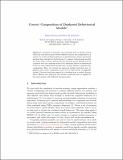Files in this item
Correct composition of dephased behavioural models
Item metadata
| dc.contributor.author | Bowles, Juliana Kuster Filipe | |
| dc.contributor.author | Caminati, Marco Bright | |
| dc.contributor.editor | Proença, José | |
| dc.contributor.editor | Lumpe, Markus | |
| dc.date.accessioned | 2017-10-19T08:30:18Z | |
| dc.date.available | 2017-10-19T08:30:18Z | |
| dc.date.issued | 2017 | |
| dc.identifier | 250701579 | |
| dc.identifier | 95ab35d0-b697-4de2-9de4-e6c3fe12bba4 | |
| dc.identifier | 85030709581 | |
| dc.identifier | 000439923900014 | |
| dc.identifier.citation | Bowles , J K F & Caminati , M B 2017 , Correct composition of dephased behavioural models . in J Proença & M Lumpe (eds) , Formal aspects of component software : 14th International Conference, FACS 2017, Braga, Portugal, October 10-13, 2017, Proceedings . Lecture notes in computer science (programming and software engineering) , vol. 10487 , Springer , Cham , pp. 233-250 , 14th International Conference on Formal Aspects of Component Software , Braga , Portugal , 10/10/17 . https://doi.org/10.1007/978-3-319-68034-7_14 | en |
| dc.identifier.citation | conference | en |
| dc.identifier.isbn | 9783319680330 | |
| dc.identifier.isbn | 9783319680347 | |
| dc.identifier.issn | 0302-9743 | |
| dc.identifier.other | ORCID: /0000-0002-5918-9114/work/58055300 | |
| dc.identifier.other | ORCID: /0000-0002-4529-5442/work/68281666 | |
| dc.identifier.uri | https://hdl.handle.net/10023/11884 | |
| dc.description | This research is supported by EPSRC grant EP/M014290/1. | en |
| dc.description.abstract | Scenarios of execution are commonly used to specify partial behaviour and interactions between different objects and components in a system. To avoid overall inconsistency in specifications, various automated methods have emerged in the literature to compose (behavioural) models. In recent work, we have shown how the theorem prover Isabelle can be combined with the constraint solver Z3 to efficiently detect inconsistencies in two or more behavioural models and, in their absence, generate the composition. Here, we extend our approach further and show how to generate the correct composition (as a set of valid traces) of dephased models. This work has been inspired by a problem from a medical domain where different care pathways (for chronic conditions) may be applied to the same patient with different starting points. | |
| dc.format.extent | 18 | |
| dc.format.extent | 420063 | |
| dc.language.iso | eng | |
| dc.publisher | Springer | |
| dc.relation.ispartof | Formal aspects of component software | en |
| dc.relation.ispartofseries | Lecture notes in computer science (programming and software engineering) | en |
| dc.subject | QA75 Electronic computers. Computer science | en |
| dc.subject | QA76 Computer software | en |
| dc.subject | RM Therapeutics. Pharmacology | en |
| dc.subject | T-NDAS | en |
| dc.subject | BDC | en |
| dc.subject.lcc | QA75 | en |
| dc.subject.lcc | QA76 | en |
| dc.subject.lcc | RM | en |
| dc.title | Correct composition of dephased behavioural models | en |
| dc.type | Conference item | en |
| dc.contributor.sponsor | EPSRC | en |
| dc.contributor.institution | University of St Andrews. School of Computer Science | en |
| dc.contributor.institution | University of St Andrews. School of Medicine | en |
| dc.identifier.doi | https://doi.org/10.1007/978-3-319-68034-7_14 | |
| dc.date.embargoedUntil | 2017-10-19 | |
| dc.identifier.grantnumber | EP/M014290/1 | en |
This item appears in the following Collection(s)
Items in the St Andrews Research Repository are protected by copyright, with all rights reserved, unless otherwise indicated.

